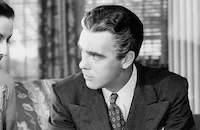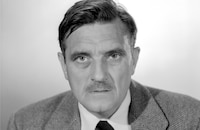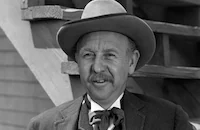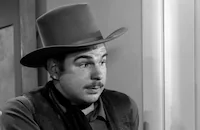High Wall

Brief Synopsis
Cast & Crew
Curtis Bernhardt
Robert Taylor
Audrey Totter
Herbert Marshall
Dorothy Patrick
H. B. Warner
Film Details
Technical Specs

Synopsis
At Brattle Press, publisher Willard I. Whitcombe learns that Steven Kenet, a former bomber pilot and the husband of his secretary, Helen, has returned home after a two-year absence and followed Helen to Whitcombe's apartment, where she has gone to pick up a manuscript. At the same time, Steven, who now has the body of his dead wife in his car, drives into a shallow river, attempting to kill himself. He is stopped, however, by the police, who determine that because of recent brain surgery, Steven, who has no memory of Helen's death, needs a psychological exam. At the Hamblin County Psychiatric Hospital, when the police hand Steven his war medal and a photograph of him with his son, the six-year-old Richard, Steven becomes despondent. Soon after, the doctors at the hospital, including Dr. Ann Lorrison, observe a blood clot in Steven's brain and note that such clots can cause emotional and physical changes and memory loss. When Steven will not consent to surgical removal of the clot, Assistant District Attorney David Wallace guesses that Steven wants to use his infirmity as a defense in his murder trial, and insists that the doctors ask Steven's mother for her consent. Ann and Wallace go to Steven's house, but find his mother dead and Richard alone and in shock. Although Ann gains temporary custody of Richard, she tells Steven that his son will go to a county orphanage unless he has the operation, which will allow him to be judged sane and gain control of his finances. Steven agrees to the surgery, which indeed cures him, but fails to restore his memory of what happened the night Helen died. Although he is permitted to visit Richard, he refuses, out of fear of facing the boy. While Steven is undergoing the final tests before being released to the court, Whitcombe is rebuffing blackmail attempts by his elevator operator, Henry Cronner, who knows how Helen died. When Cronner offers the information to Steven instead, Whitcombe kills him before he can divulge the information. Cronner's offer, however, has made Steven realize that regaining his memory might prove his innocence, so he takes a truth serum, sodium pentothol, from Ann and recounts the events of the evening of Helen's death: On the night that she died, Steven finds her at Whitcombe's house, clearly having an affair with her boss, and starts to attack her out of jealousy but blacks out and wakens to find her dead. Back in the present, Ann watches Steven fall asleep, and is startled when she later finds him hiding in her car. Steven forces her to drive him to Whitcombe's, where he re-enacts the murder night's activities. He also remembers seeing a suitcase there that night, but notes that it had been removed by the time he awakened, suggesting that someone else had been in the room. Ann decides not to turn Steven in, and they leave the apartment looking just as it did that night, causing Whitcombe to panic when he comes home. After receiving word that he has been made a partner in his firm, Whitcombe visits Steven and baits him into attacking him by telling him that he killed Cronner and Helen. As a result of the attack, Steven is placed in permanent seclusion. When Ann visits him, Steven tells her what has happened, grabs her keys and escapes to prove his innocence, prompting a city-wide manhunt. The next day, Ann finds him outside Whitcombe's apartment and tells him she loves him. Together they trap Whitcombe, inject him with sodium pentathol and convince the police to listen as Whitcombe confesses that he murdered Helen, who threatened to ruin him if he did not marry her. Later Ann brings Steven, whose name is now cleared, home to see Richard, and they embrace.

Director

Curtis Bernhardt
Cast

Robert Taylor

Audrey Totter

Herbert Marshall

Dorothy Patrick

H. B. Warner

Warner Anderson

Moroni Olsen

John Ridgeley

Morris Ankrum

Elisabeth Risdon

Vince Barnett

Jonathan Hale

Charles Arnt
Ray Mayer
Bobby Hyatt
Dick Wessell
Robert E. O'connor
Celia Travers
Mary Servoss
Eula Guy
Jack Davis
Tom Quinn
Frank Jenks

Irving Bacon
Kate Mackenna
Russell Arms
Al Hill
Erville Alderson
William Fawcett
Stanley Price
Joel Friedkin
Frank Marlowe
John Beck
Henry Sylvester
Phil Dunham
Skeets Noyes
Dorothy Neumann
Helen Eby-rock
Milton Kibbee
George Bunny
Bob Wendal
Sammy Shack
Hank Worden
Georgia Caine
Boyd Davis
Henry Hall

Howard Mitchell
Frank Darien
Guy Beach

Ray Teal

Bernard Gorcey
Bert Hanlon
Selmer Jackson
John R. Hamilton

Lee Phelps

Matt Willis
Bob Williams
Eddie Dunn
Jim Drum
Paul Kruger
Jack Worth
Lisa Golm
Grandon Rhodes
Perry Ivins
Dorothy Vaughn
Jean Andren
Marta Mitrovich
Dan Quigg
Tay Dunn
Jack Baxley
Jack Chefe
Abe Dinovitch
Rhea Mitchell
Crew
Peter Ballbusch
Sydney Boehm
Lester Cole
Jack Dawn
Cedric Gibbons
A. Arnold Gillespie
Sydney Guilaroff
Joseph W. Holland
Bronislau Kaper
Robert Lord
Conrad A. Nervig
Warren Newcombe
Al Raboch
Douglas Shearer
Leonid Vasian
Paul Vogel
Charles E. Wallace
Edwin B. Willis

Videos
Movie Clip




Trailer
Hosted Intro
Film Details
Technical Specs

Articles
High Wall
Taylor plays Steven Kenet, a war vet who is suffering from a recurring brain injury that causes him to be overly anxious and paranoid around people. When he returns home from the war, he discovers that his wife (Dorothy Patrick) has been having an affair with Willard Whitcombe (Herbert Marshall), a pious publisher of religious books. One day Kenet wakes up and discovers that his wife has been strangled to death. He's found guilty of the murder and committed to a county asylum where he is treated by Dr. Ann Lorrison (Audrey Totter). At first she's doubtful of his innocence, but eventually she agrees to help him uncover the identity of the real killer.
High Wall is filmed in the classic film noir tradition and director Curtis Bernhardt gives it a strong sense of style, complete with rain drenched streets, claustrophobic apartments, violent whirlpool flashbacks and disturbing subjective shots which emphasize the film's chaotic and often bleak tone. Bernhardt actually got the inspiration for Taylor's character from his own wartime experiences. In an interview with Mary Kiersch, the director recalled how he and a companion "were walking across a railroad bridge. We looked down at a trainload of soldiers returning from the front. It was one of the most frightening sights of my life, because I knew that the entire train was filled with dying people. The noise of that engine, with the steam hissing out, against the deadly silence in those cars. I knew what was in store for me if I went to the front. Taylor's character must have had similar experiences. I think I took employment at MGM because of High Wall. I suddenly saw a chance to bring directly to the American people the experience of the war. In the American pictures, this experience is treated as a kind of ballyhoo concept. The Best Years of Our Lives came after High Wall."
Obviously, High Wall was MGM's attempt to duplicate the success Bernhardt had had with similar material at Warner Brothers like Possessed (1947) in which Joan Crawford played a schizophrenic woman who commits a murder. Studio mogul Louis B. Mayer also figured that if a former romantic lead like Ray Milland could convincingly play an alcoholic on a binge in a dark-themed movie like Billy Wilder's The Lost Weekend (1945), then matinee idol Robert Taylor could play a mentally disturbed war veteran. While High Wall is not in the same league as Billy Wilder's film, Taylor gives an impressive performance and he's greatly aided by a superb ensemble cast. As the sympathetic psychiatrist, Audrey Totter (a former radio actress who was always a strong presence in film noirs like The Postman Always Rings Twice (1946) and Lady in the Lake (1947) - is a reassuring combination of resolve and compassion. The urbane Herbert Marshall uses his cultivated voice and mannerisms to superb effect as the duplicitous Whitcombe and has the film's most memorable scene: He spies a potential witness to his crime, a suspicious elevator operator (Vince Barnett) trying to repair an elevator, its door open to the deep shaft below while he stands on a stool. As Whitcombe saunters by, he extends his umbrella, hooking the handle around one of the stool's legs, jerking it to the ground and sending the elevator man down the shaft to his death!
One of the most fascinating aspects of High Wall is the film's disturbing connection to the House of un-American Activities Committee (HUAC) witch-hunts of the late 1940's and early 1950's. Taylor was a staunch Republican, who along with his then wife Barbara Stanwyck, became the founders of The Motion Picture Alliance for the Preservation of American Ideals. A group of Hollywood players formed as a backlash against the unionization of the industry and a reaction against the left-wing intellectuals of FDR's new deal era and cutting edge leftists sentiments in the arts. Films like Clifford Odets take on the corrupt nature of free enterprise in Golden Boy (1939) and Song of Russia (1943), which praised the Soviet Union (and starred Taylor), had him convinced that the screenwriters had a powerful forum - the movies - to push forth their ideas. It was proved quite the opportunity for Taylor when (HUAC) had subpoenaed him to testify on October 22, 1947 regarding his knowledge of "subversives" in the industry. Taylor made clear that the primary manner by which communism had infiltrated the movie industry was through the screenwriters and that they had to be watched closely. With newsreel cameras rolling, Taylor was asked to name someone, and he did Lester Cole, the screenwriter for High Wall (for more details on HUAC's Hollywood witch-hunts of the era, read Victor Navasky's fascinating book, Naming Names).
By sharp contrast to Taylor, Cole was one of infamous "Hollywood Ten", a group of writers and directors who refused to testify when subpoenaed by the (HUAC) regarding their knowledge of or possible involvement in Communist Party activities. Cole, who was running for re-election of the Screen Writers Guild when subpoenaed, was a hard-line Communist fingered as a subversive screenwriter but stood by the first amendment's guarantee against incursions on free speech and refused to be a cooperative witness. He was eventually found in contempt in Congress and would serve a one-year prison sentence, giving High Wall a sobering footnote in Hollywood history.
Producer: Robert Lord
Director: Curtis Bernhardt
Screenplay: Sydney Boehm, Lester Cole, based on a story and play by Alan R. Clark and Bradbury Foote
Art Direction: Cedric Gibbons, Leonid Vasian
Cinematography: Paul Vogel
Editing: Conrad A. Nervig
Music: Bronislau Kaper
Cast: Robert Taylor (Steven Kenet), Audrey Totter (Dr. Ann Lorrison), Herbert Marshall (Willard I. Whitcombe), Dorothy Patrick (Helen Kenet), H. B. Warner (Mr. Slocum), Warner Anderson (Dr. George Poward), Morris Ankrum (Dr. Stanley Griffin).
BW-100m. Closed captioning.
by Michael T. Toole

High Wall
Quotes
Trivia
Notes
This film marked director Curtis Bernhardt's and screenwriter and producer Robert Lord's first assignments at M-G-M. High Wall was the last screenplay that Lester Cole wrote before his testimony at a November 1947 House Committee on Un-American Activities (HUAC) hearing into suspected Communist infiltration of the motion picture industry. After challenging the right of the committee to demand information about his political affiliations, Cole was cited for contempt of Congress, imprisoned for one year and blacklisted by Hollywood. According to an October 1947 New York Times article, High Wall star Robert Taylor testified at a HUAC hearing that he suspected that Cole was a Communist. The New York Times article also notes that Morrie Ryskind, another writer who testified before the committee, "asserted that Lester Cole was unquestionably a Communist." While High Wall marked Cole's last screen credit under his real name, he later wrote screenplays under assumed names. (For more information on the HUAC hearings, see the entry above for Crossfire). Actors Van Heflin and Janet Leigh starred in a November 7, 1949 Lux Radio Theatre version of the story.

















